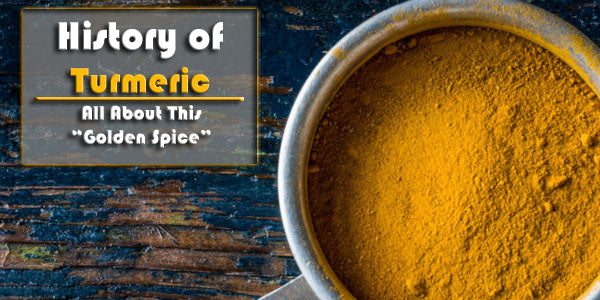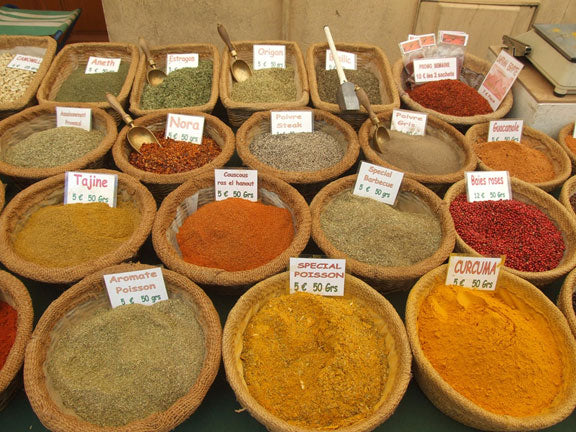History of Turmeric - An In Depth Look at How This Golden Spice Became So Powerful

The turmeric plant has been cultivated for thousands of years and has played a significant role in the cuisine, medicine, and cultural practices of India and other Asian countries.
Once Europeans and Americans were introduced to turmeric root, it became a staple of many Western kitchens as well. It has also been – and is still – the subject of a great deal of scientific research to uncover the secrets of turmeric's healing properties.
If you’re interested in exploring the history behind all the benefits of turmeric, read on to learn more about this fascinating golden spice.
The Names of Turmeric Curcumin And Their Meanings
The turmeric plant is known by many different names around the world. Many languages use a word that means “yellow,” since the rich color of turmeric root is its most noticeable feature.
The yellow color of the turmeric rhizome or root comes from a component of the plant known as curcumin. Many European languages use words that are similar to either “turmeric” or “curcumin,” while other languages use words that describe the plant by its color, aroma, or other characteristics.
In India, where turmeric was first cultivated, the spice is most commonly known as haldi, a Hindi word derived from the Sanskrit haridra, which also means “yellow.” The Tamil language in South India also named turmeric for its color with the word manjal.
In Sanskrit literature, turmeric has more than 50 different names referring to its color, its uses, and other characteristics. For example, the name bhadra means “fortunate,” the name jawarantika means “cure for fever,” and the name patwaluka means “aromatic powder.” Some other names indicate how highly the spice was valued, like kanchani (“golden goddess”), hridayavilasini (gives delight to the heart), and tamasini (“beautiful as night”).
In Chinese, where turmeric is used extensively in traditional Chinese medicine, the word for the spice is jianghuang, or literally “yellow ginger.”
In the Persian language, turmeric is known as zardchube or “yellow wood,” and it is commonly used in Iran both for cooking and medicinal purposes.
In French, turmeric is called safran des Indes, or “saffron of India.”
Etymology Of “Turmeric” And “Curcuma”
The etymology of “turmeric” (which can be pronounced either “TUR-mer-ick” or “TOO-mer-ick”) is somewhat obscure, but it is thought to be derived from the Latin terra merita, which means “merited earth.”
The first spelling of the word in Old English was “tamaret,” which bears more similarity to the Latin phrase than the modern spelling. The botanical name of the plant is Curcuma longa, and the word curcuma comes from the Arabic word kurkum (derived from Sanskrit kunkuma), which means “saffron,” another spice with a similarly rich yellow-orange color.
History of The Cultivation Of The Turmeric Plant

It’s not known for certain where the plant first grown or where it was first used by humans, but most scientists and historians have found evidence that suggests the plant was originally cultivated in South Asia, where it spread to Southeast Asia and Indonesia.
There is evidence of turmeric on the island of Java in the 5th century A.D., and it is thought to have spread to China sometime in the 7th century. The spice was well established in Chinese culture by the time Marco Polo visited in the 13th century and wrote about an orange root that was similar in color to saffron.
The earliest physical evidence of turmeric use by humans comes from ancient pots found near New Delhi, India.
When scientists examined the residue of spices at the bottom of these pots, they were able to determine that the residue contained traces of powdered turmeric root that were more than 4,500 years old.
The earliest written evidence of turmeric use is found in an Egyptian papyrus dated around 1500 B.C. The document mentions turmeric as a dye and as a medicine.
Ayurvedic literature provides evidence that turmeric played a key role in the Vedic culture of India as early as the year 250 B.C. In 659, turmeric is included in a comprehensive pharmacopeia called the Tang Materia Medica, a book published in China during the Tang Dynasty.
Turmeric is also mentioned in descriptions of the Hanging Gardens of Babylon. This cultural plant has since spread to many parts of the world, and its powdered root is used for a wide range of purposes.
As trade routes expanded, the spice made its way further west. It was introduced in East Africa around 800 AD, and it made its way across the continent to West Africa a few hundred years later. By the 18th century, Jamaica had turmeric as well. The spice was known in the U.S. in the nineteenth century.
How Turmeric Entered Western Culture
Around the time that Marco Polo was discovering the saffron-colored root in China, Arab traders were bringing turmeric and other eastern spices to Europe, and from Europe, it spread to American culture. Turmeric became more widely known in the West when the British colonized India and discovered curry. Originally spelled “kari,” the spice blend, which depends on turmeric for all its color and much of its flavor, was first mentioned in a 17th-century Portuguese cookbook.
The first English recipe calling for turmeric is a pickle recipe published in The Art of Cookery made Plain and Easy by Hannah Glasse in 1747. The first English curry recipe is found in a later edition of the same cookbook. In 1831, curry first appears in an American cookbook, The Virginia Housewife by Mary Randolph.
While turmeric was famed not just for its flavor but for its powerful healing properties in India, China, and the Middle East, it was known primarily as a kitchen spice in Europe and the U.S. until quite recent times.
Around the middle of the twentieth century, holistic medical practitioners began turning their attention to the health benefits of turmeric, and since then, there has been extensive scientific research on the medicinal properties of the plant. Nowadays, turmeric is widely available in the U.S. and Europe, both as a culinary spice and as a health supplement.

The Discovery of Curcumin
One of the milestones in the history of turmeric was the discovery of curcumin, the yellow-colored substance in the root of the plant that is primarily responsible for its health benefits.
Curcumin was first discovered in 1842 by two German scientists, Vogel and Pelletier, who isolated a yellow-colored material from the turmeric rhizome and gave it the name “curcumin.”
The product they isolated was later found to be a combination of resin and turmeric oil, rather than a pure distillation of curcumin. Nonetheless, they took the first step.
In 1910, Milobedzka and Lampe described the chemical structure of the compound. The first paper investigating the medicinal properties of curcumin was published in the journal Nature in 1949, and the authors reported on curcumin benefits for fighting microbial diseases.
Since then, more than 4,000 laboratory and clinical studies on the health benefits of curcumin have been published.
Traditional Culinary Uses of Turmeric Around The World
As a seasoning, turmeric has an earthy, warm, and slightly bitter flavor. It is used widely in the cuisine of India, Southeast Asia, the Middle East and North Africa.
This spice is mainly used in the West to prepare Indian, Middle Eastern, and Asian dishes, though it is becoming an increasingly popular additive to many traditional recipes, like soups and stews. Although it is most often added to savory dishes, turmeric can also be used in rice, baked goods, sweets, and even beverages. Traditionally, turmeric has many uses that span thousands of years and multiple cultures.
Turmeric in Indian Cooking
In India, turmeric is not only used in curries but in a variety of main dishes,  desserts, and drinks. It is used to add both color and flavor to many chutneys, pickles, lentil stews, and soups. It is also an ingredient in many vegetable dishes, like gobi sabji, or steamed cauliflower, and meat dishes, like turmeric chicken and rice. It can also be mixed with scrambled eggs. The yellow spice is also used in some varieties of garam masala, a spice mix that is almost as ubiquitous as curry in Indian cuisine.
desserts, and drinks. It is used to add both color and flavor to many chutneys, pickles, lentil stews, and soups. It is also an ingredient in many vegetable dishes, like gobi sabji, or steamed cauliflower, and meat dishes, like turmeric chicken and rice. It can also be mixed with scrambled eggs. The yellow spice is also used in some varieties of garam masala, a spice mix that is almost as ubiquitous as curry in Indian cuisine.
Turmeric is also used in some sweet dishes, like pataleo, or coconut leaf cake. This dish is made by combining rice flour, coconut, and sugar, and then steaming the mixture in turmeric leaves.
One of the most well-known Indian beverages is a sweet drink made with turmeric called haldi doodh, known as a turmeric latte or golden milk. This South Indian recipe blends turmeric with a non-dairy milk (most often coconut milk), black pepper, and honey or another sweetener.
Turmeric in East Asian Cooking
Although turmeric is used in India more than in any other country, other cuisines have also adopted this earthy and healthful seasoning for certain dishes. For example, in Thai food, yellow curry or kaeng kari is made with turmeric, coriander, lemongrass, cinnamon, cumin, fenugreek, mace, and a few other seasonings.
In Singapore, you can find many dishes with turmeric, including satay, lamb stew, and spicy prawns. Certain regions of China, like Xinjiang and Tibet, use turmeric in meat and vegetable dishes, but in general the spice is better known in China for its medicinal uses.
Turmeric in Middle Eastern and North African Cuisines
Turmeric is one of the most popular spices throughout the Middle East. It is especially common in Moroccan cooking, where turmeric has been in use ever since the 7th century, when it was first introduced by Arab traders.
Spicy slow-cooked stews, or tagines, and couscous dishes almost always contain turmeric. A popular Moroccan turmeric recipe is chebakia, a chewy cookie made during Ramadan that also contains almond flour, sesame seeds, honey, and orange blossom water.
In Egypt, turmeric is blended with other spices like fenugreek and ginger to make an aromatic tea. Iraqis use turmeric to make mango pickles, a popular condiment. In Yemen, turmeric is a key ingredient in a spice blend for making Chicken Mandi, a classic Yemeni dish of roasted chicken with rice.
Other culinary uses of turmeric throughout the Middle East include adding it to rice, using it in falafel, and baking it into cakes.
The Role of Turmeric in Cultural Practices
In India and other parts of Asia, many other benefits of turmeric are recognized, including its color and its value as a good luck charm. The following are some cultural traditions that incorporate turmeric, along with some everyday uses of the spice that are unique to certain cultures.
The Use of Turmeric in Wedding Customs
At a typical Indian wedding, the groom puts a turmeric-dyed string known as a thaali or mangal sutra around the neck of his bride to signify that she is his wife and the marriage is finalized. This custom is like the exchange of rings in a Western marriage.
The bride and groom may also anoint each other’s foreheads with a yellow powder made of turmeric and sandalwood to bring good fortune to their union. In the past, the wedding clothes were often dyed with the spice because it was believed that turmeric dye would protect the wearer from getting a fever. Nowadays, many Hindu brides still apply turmeric to their bodies on their wedding day.
Turmeric for Good Luck
Another cultural tradition involving turmeric comes from an ancient Indian people who worshipped the sun. Because turmeric’s golden color reminded them of their deity, they considered it to be a holy substance. Although the culture died out long ago, the custom of wearing a piece of dried turmeric root as a kind of good luck charm still survives in southern India.
Turmeric was also once thought to bring good fortune to married women, who would put turmeric on their faces to welcome the goddess Lakshmi. Throughout India, turmeric has been considered protective for mothers and babies just after childbirth. In some parts of the country, there is also a tradition of burying the umbilical cord in hole together with turmeric rhizome, turmeric-stained grains of rice, and betel nut.
Turmeric as A Dye
Turmeric has been used as a dye for clothing throughout Asia. Not only is turmeric one of the strongest natural dyes, imparting a deep color, but Indian dye-makers considered it a safe and healthy substance to be worn close to the skin.
Buddhist monks, for example, wear yellow-orange robes dyed with turmeric. In Kerala, India, children wear turmeric-dyed robes for Onam, an ancient Hindu harvest celebration.
Turmeric has also been used to color paint for decorating tribal masks and other forms of religious and folk art. Some anthropologists posit that turmeric was cultivated for its use as a dye when humans first adopted agriculture.
In Polynesia, red is considered a royal color, and Polynesians developed a method of creating a red-orange dye from the turmeric root. The process involved scraping and repeatedly straining the root in order to separate out the heavier particles. The strained liquid, still containing fine particles, was then cooked until it solidified and mixed with coconut oil to produce a deep red-orange dye.
Other Uses of Turmeric
Turmeric has many practical purposes as well, such as being used as an insect repellent. For years, women have used turmeric paste to remove hair and to brighten their complexions. Turmeric has also been used as a whitener for the teeth and even as an anti-dandruff treatment.
Medicinal Uses of Turmeric
For most of its history, turmeric has been valued not only as a cooking ingredient and colorful dye, but also as a healing herb. The curcumin in the turmeric rhizome and root is known to have many medicinal properties, including fighting inflammation and combatting oxidation caused by free radicals. The plant is well-known in traditional healing practices throughout Asia.

Uses of Turmeric In Ayurvedic Medicine
Turmeric has long played a role in Ayurvedic medicine, a holistic healing tradition that originated in ancient India. In fact, turmeric root is mentioned in some of the earliest Ayurvedic literature dating back to the 6th century. However, far from being a purely historical practice, Ayurveda is alive and well in India and around the globe. Many rural Indians today still rely primarily on Ayurvedic medicine for their health care.
According to the Ayurvedic tradition, there are three basic energies that circulate through the body, called doshas. These three doshas - vata, pitta, and kapha - are associated with the nervous system, the digestive system, and the lymphatic system, respectively. Every individual maintains a unique balance of these energies when he or she is in good health. According to Ayurvedic philosophy, disease occurs when these energies are not in balance. Turmeric is one of the foods that is believed to restore balance to the doshas, and it is incorporated into a wide array of Ayurvedic therapies, both as a dietary supplement and in some cases, as a topical application.
Uses of Turmeric In Chinese Medicine
Traditional Chinese Medicine (TCM) is another ancient medical tradition that dates back thousands of years. Like Ayurveda, TCM is also an energy-based philosophy of health and healing that evolved from Taoism, and it implements physical exercise, acupuncture, massage, diet, and herbs to treat disease.
According to TCM, the human body is a microcosm of the whole universe, and the energy of the universe, or qi, flows through each body. When qi is blocked, the body is at risk of developing disease. Chinese doctors consider turmeric, or jianghuang, to be one of the herbs that can unblock or restore balance to energy flow. Turmeric is considered a warming food that supports organ function and overall wellness.
Uses of Turmeric In Other Healing Traditions
Unani is a healing tradition that emerged in Persian and Arabic culture, and it is based on the ancient Greek medical philosophy that the body consists of four humors (blood, phlegm, black bile, and yellow bile) that need to be in balance.
Currently practiced in India and Central Asia, Unani practitioners recommend turmeric for a range of disorders and symptoms. In Pakistani and Afghani folk medicine, turmeric is used to heal both internal disorders and skin wounds or inflections. In Afghanistan, the spice is applied to a burned cloth and pressed on to an injury to heal and disinfect the wound.
Turmeric is also one of the herbs commonly used in Kampo, a traditional Japanese system of medicine based on TCM. In modern-day Japan, turmeric tea is consumed before drinking alcohol as a hangover preventative and protection for the liver. Many Japanese also drink turmeric tea regularly to promote longevity. In Korea, turmeric is used by traditional herbalists who practice a very similar form of holistic medicine derived from the Chinese system.
Learn More About Your Turmeric Supplement
In many ways, turmeric is both ancient and very modern.
In India, where the plant was first cultivated and appreciated for its health benefits, it has always been a staple of the diet and a home remedy for many ailments.
In the West, people are becoming newly aware of the remarkable health benefits that turmeric offers and are turning to the spice as an alternative natural treatment for pain and disease.
Me First Living’s World of Turmeric section discusses the uses of curcumin and turmeric, various health benefits, and much more.
If you want to become a part of a pain-free way of living, then join us; we guarantee you’ll love our turmeric supplements. Learn to make the best decisions for your health